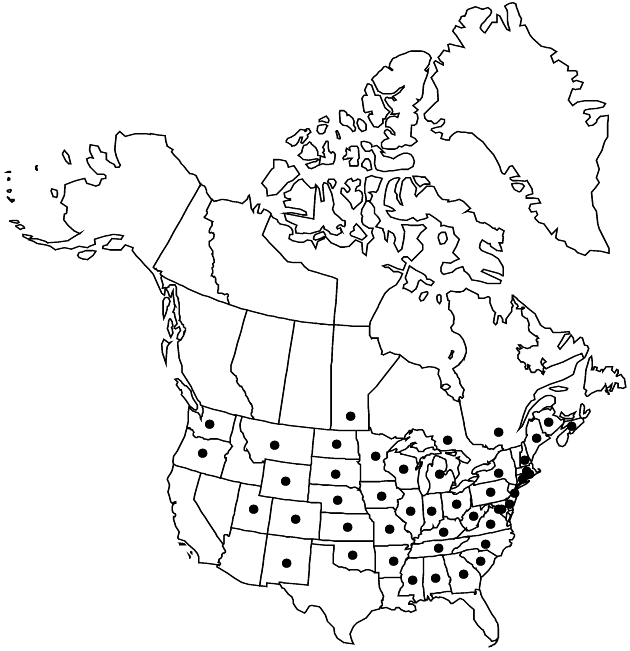Symphyotrichum novae-angliae
Phytologia 77: 287. 1995.
Perennials, 30–120 cm, cespitose; with thick, woody, branched caudices, or short, fleshy rhizomes, sometimes with woody cormoid portions. Stems 1–5+, erect (stout, light to dark-brown, sometimes purplish distally), proximally sparsely to moderately hispiduloso-hirsute or pilose, distally moderately to densely so, stipitate-glandular. Leaves (light to dark green) thin, often stiff, margins entire or sometimes with shallow teeth, ciliate; basal withered or withering by flowering, sessile, blades (3-nerved) usually spatulate, sometimes oblanceolate, 20–60 × 5–15 mm, bases attenuate, apices acute, faces sparsely hirsute; proximal cauline withering by flowering, sessile, blades oblong or lanceolate, 50–100 × 5–15 (–20) mm, bases auriculate-clasping, margins entire, pustulate-scabrous, apices acute, mucronulate, faces stipitate-glandular, abaxial thinly strigose, adaxial hirsute or hispidulous; distal sessile, blades oblanceolate, 30–80 × 6–15 mm, gradually reduced distally, bases auriculate-clasping, apices acute to obtuse, mucronate to minutely white-spinulose, faces moderately to densely short-soft-hairy, sparsely to moderately stipitate-glandular. Heads in leafy, often crowded, paniculo-corymbiform arrays. Peduncles dilated distally, 0.3–4 cm, densely short-hairy, stipitate-glandular, bracts 1–4, foliaceous, linear to narrowly lanceolate, densely short-hairy, stipitate-glandular, grading into phyllaries. Involucres campanulate to hemispheric, (5–) 7–9 (–15) mm. Phyllaries in 3–5 (–6) series (dark green to purple-tinged), linear-lanceolate, subequal, outer foliaceous, mid and inner scarious in basal 1/3–1/2, margins stipitate-glandular, apices long-acuminate to acuminate, spreading to reflexed or squarrose, faces glabrous, outer densely stipitate-glandular. Ray-florets (40–) 50–75 (-100); corollas dark rose to deep purple (pale-pink or white), laminae 9–13 × 0.8–1.3 mm. Disc-florets 50–110; corollas light yellow becoming purple, (4–) 4.5–5.5 (–7) mm, tubes ± 1/2 narrowly funnelform throats (glabrous or thinly puberulent), lobes triangular, 0.4–0.7 mm. Cypselae dull purple or brown, oblong or obconic, not compressed, 1.8–2.5 (–3) × 0.6–1 mm, 7–10-nerved, faces densely sericeous, sparsely stipitate-glandular; pappi tawny (barb tips sometimes rose-tinged), 4.5–6 mm. 2n = 10.
Phenology: Flowering Aug–Oct(–Nov).
Habitat: Open, moist to wet, sandy or loamy, rich soils, fields, prairies, meadows, marshy grounds, shrubby swamps, fens, shores, thickets, moist edges of woods, roadsides, railroad rights-of-way, somewhat weedy
Elevation: 0–1600 m
Distribution

Man., N.B., N.S., Ont., Que., Ala., Ark., Colo., Conn., Del., D.C., Ga., Ill., Ind., Iowa, Kans., Ky., Maine, Md., Mass., Mich., Minn., Miss., Mo., Mont., Nebr., N.H., N.J., N.Mex., N.Y., N.C., N.Dak., Ohio, Okla., Oreg., Pa., R.I., S.C., S.Dak., Tenn., Utah, Va., Wash., W.Va., Wis., Wyo., in Europe
Discussion
Symphyotrichum novae-angliae is escaped from cultivation and introduced in Montana, Oregon, Utah, Washington, and Wyoming, and has been reported as an ephemeral escape in British Columbia. It possibly escaped from cultivation elsewhere. The Michaelmas daisy is widely sold in the horticultural trade, where cultivars have been developed. Forms have been described that correspond to color genetic variants within natural populations {Aster novae-angliae forma roseus (Desfontaines) Britton; A. novae-angliae forma geneseensis House}; they are not recognized here.
Symphyotrichum novae-angliae resembles Canadanthus modestus, but the ranges of the two do not overlap, and the latter has sparsely hairy cypselae with dark ribs. Symphyotrichum novae-angliae hybridizes with S. ericoides, forming the F1 intersectional hybrid S. ×amethystinum.
Selected References
None.